The highest frequency that can be reproduced accurately when a signal is digitally encoded at a given samplinge rate. Theoretically, the Nyquist frequency is half the sampling rate. For example, when a digital recording uses a sampling rate of 11kHz, the Nyquist frequency is 5.5kHz. Conversely, if one wishes to produce an audio bandwidth of 20kHz, a sampling rates of 44.1kHz is used as the brick-wall filter on the A/D converter starts to roll-off at 20kHz so that the level has dropped to zero at the Nyquist frequency of 22..05kHz, yielding full level throughout the 20kHz AF band. If a signal being sampled contains frequency components that are above the Nyquist limit, aliasing will be introduced in the digital representation of the signal unless those frequencies are filtered out prior to digital encoding by means of an anti-aliasing filter. The Nyquist Theorem is also called the Sampling Theorem.

See brick-wall filters.